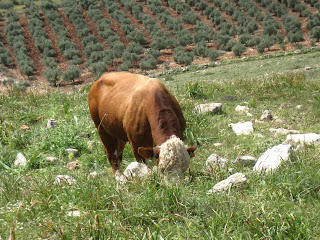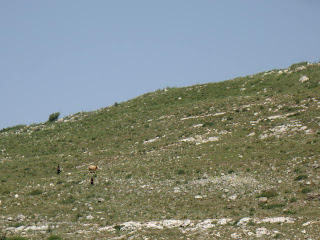Anyway.
To get to the site of Cana, we drove into an area almost entirely settled by Palestinians, where each small village had its own mosque with a minaret and a green dome, and all the signs were in Arabic.
As we passed in our four-car caravan, pedestrians gave us curious glances. We left the main road and proceeded to follow a rocky path which hardly deserved the appellation of "road." Thistles rose on either side of us, some over seven feet tall, with nasty pointy spikes.
We passed the fields of Palestinian farmers tucked away in the valley. The further we strayed from the main road, the more I thought about how we might be viewed by those who owned these fields. It was sort of a disquieting feeling.
Finally we reached the spot where we parked the cars. After a lunch that included matzo, hummus, olives, kohlrabi, we girded our loins (read: put on sunblock, hat with attached sunshade, and long-sleeved shirt) and set off.
The path soon ended and we began hiking straight up the hill. It was hot and rocky and soon I abandoned the straight-up approach for a modified switchback, following the cow paths. We arrived at the top hot, sweaty and a bit red-faced.
The modest ruins at the top would scarcely belie the biblical significance of the site.

I poured a libation (I am sorry to report that my water remained in its aqueous state.) A curious cow and her offspring wandered by.
Going up was hard, but going back down was even harder, as the loose rocks could be very treacherous.
But we made it safely back down.












